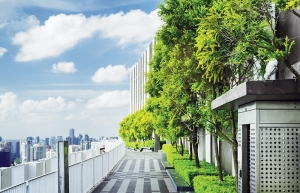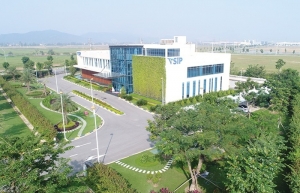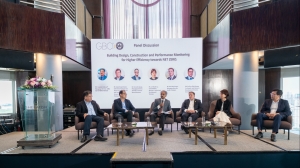Green-certified office buildings on the rise
 |
| Green-certified office buildings on the rise, Photo: Shutterstock |
Standard Chartered Bank Vietnam’s head office in Hanoi was the latest to be awarded LEED Gold certification at the beginning of September, demonstrating the bank’s commitment to sustainability and delivering the most environmentally conscious design.
The bank has fulfilled the standards set by the LEED Green Building rating system of the US Green Building Council (USGBC). The verification includes a range of factors including energy efficiency, human health and wellbeing, water conservation, indoor environmental quality, sustainable and regenerative material cycles, and active community engagement.
Michele Wee, CEO of Standard Chartered Bank (Vietnam), said that certification reflected the bank’s shared values and commitment to crafting spaces that excel in functionality while minimising ecological footprint.
“Standard Chartered commits to continuing to drive sustainable economic growth, embrace responsible practices, and invest in the Vietnamese community,” she said.
Also at the beginning of September, Frasers Property Vietnam (FPV) announced that its commercial building Worc@Q2 had received LEED Gold certification for operations and maintenance.
The certification, also from the USGBC, recognises the building’s strong sustainable and healthy building practices. Worc@Q2 is FPV’s first commercial building to receive such certification, setting a new industry benchmark and reflecting the company’s commitment towards sustainability.
According to Edwin Tan, deputy CEO, FPV has the goal to green certify the vast majority of its owned and asset-managed properties by 2024.
“Benchmarking our properties to international green building standards is part of how we embed sustainability across our assets’ lifecycle, which helps ensure our portfolio remains resilient and future-proof as well as aligned with the country’s net-zero carbon commitment,” Tan said.
Peter Templeton, president and CEO of the USGBC, said that the work of innovative building projects, such as the Worc@Q2 office, was a fundamental driving force in transforming the way it builds, designs, and operates buildings.
“Buildings that achieve LEED certification contribute to reduced carbon emissions, lower operating costs, and conserving resources while prioritising sustainable practices and the wellbeing of its occupants,” Templeton said.
It is no coincidence that the green office trend has flourished in the market. Since November 2020, companies listed on the Vietnamese stock exchange must publish environmental, social, and governance reports as well as environmental and social impact assessments. All businesses need to evaluate criteria such as greenhouse gas emissions, energy, and water savings.
As a result, the office market has witnessed a significant increase in the demand for renting new buildings, built and completed with high-quality technical systems, which are sustainable and environmentally friendly green buildings.
Having to report and evaluate environmental impact criteria has affected the rental market, with added economic complexities and a number of businesses being dissolved this year, while Grade A offices with green certification still operate actively.
According to Nguyen Thi Thuy Nguyen, director and head of Office and Industrial Park Leasing at CBRE Vietnam, green trends in real estate are being taken more seriously not only because of the negative impacts from climate change, but also because of investor expectations that they will receive higher rents with green certification.
“Going green is no longer a trend but an urgent need in construction projects, especially for commercial and office projects and buildings. It requires deep attention and commitment from all levels of staff at each company and within government. Customers belonging to multinational corporations have raised green office standards as a mandatory factor in choosing an office,” Nguyen said.
She added that more and more new relatively large-scale commercial/office projects are being built with green criteria, while older projects and buildings have been and will be upgraded to meet the needs of customers, as well as increase competitiveness.
Figures from CBRE Vietnam show that Ho Chi Minh City currently boasts 11 green-certified offices, and this will increase to 18 in the next three years. This number in Hanoi is slightly lower with four current buildings, though this is expected to double in the same period.
 | Breaking barriers in green buildings The absence of a financial priority mechanism, the cumbersome registration process, and the fear of increasing investment capital are the main barriers hindering greener construction projects in Vietnam. |
 | Developing sustainably with rise of green buildings In 1990, the Building Research Establishment’s Environmental Assessment Method (BREEAM) was born in the UK, marking the world’s first foundation of green building. |
 | Vietnam ranks 28th worldwide in terms of green buildings With over 250 LEED-certified constructions over the last decade, Vietnam is increasingly demonstrating the relevance of green aspects in architectural design, operations, and the maintenance of existing buildings. |
 | Vietnam's 300 certified green buildings yet to reach net-zero As Vietnam intensifies its focus on sustainability, the nation's progress is spotlighted with a modest tally of 300 certified green buildings. To date, no building in Vietnam has been designed, constructed, or managed to meet net-zero criteria. |
What the stars mean:
★ Poor ★ ★ Promising ★★★ Good ★★★★ Very good ★★★★★ Exceptional
Related Contents
Latest News
More News
- JustCo expands business into Vietnam (December 22, 2025 | 17:58)
- Sun Group breaks ground on $2 billion Van Don casino complex (December 19, 2025 | 18:14)
- Rare, beautiful, sustainable: the mark of iconic real estate (December 19, 2025 | 08:00)
- Owner-occupied housing stabilises, paving the way for new growth cycle (December 18, 2025 | 17:04)
- Unlocking urban potential of smart cities (December 18, 2025 | 16:50)
- Green finance offers 'passport' for Vietnamese construction, building materials firms (December 15, 2025 | 08:00)
- Gamuda Land commit long-term investment (December 12, 2025 | 11:49)
- HITC ties up with Evolution to develop AI and hyperscale data centres in Vietnam (December 11, 2025 | 12:09)
- Real estate deals boom via high-profile names (December 08, 2025 | 11:32)
- Industrial segment shaped by M&As (December 08, 2025 | 08:00)

 Tag:
Tag:




















 Mobile Version
Mobile Version